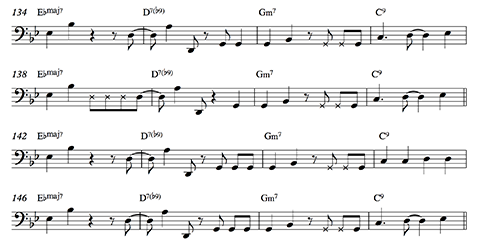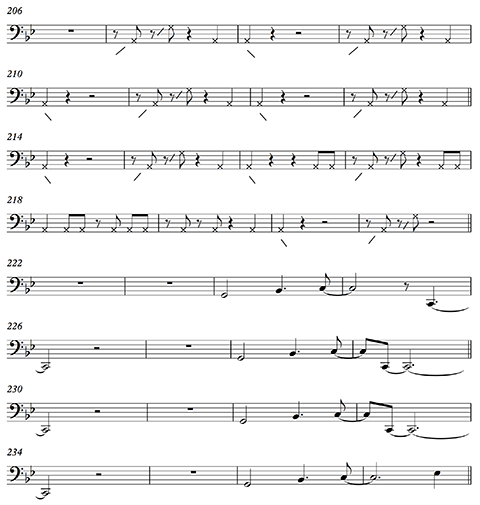Indice - Table of contents
New Stuff[hide]
Reportes: From The St... : Cubadisco 2...
Tienda: Cuban Music Store
Reportes: From The St... : Cubadisco 2...
Fotos: Tom Ehrlich
Staff: Kristina Lim
Musicos: Juan Formell
Musicos: Yordamis Megret Planes
Musicos: Yasser Morejón Pino
Musicos: José Luis "Changuito" Quintana...
Musicos: Dennis Nicles Cobas
Fotos: Eli Silva
Grupos: Ritmo Oriental : 1988 - Vol. IX - 30 a...
Musicos: Rafael Paseiro Monzón
Musicos: Jiovanni Cofiño Sánchez
Photos of the Day [hide]
Inmadura
As with many premier recordings "Te gusto o te caigo bien" is that of an emergent ensemble. Bamboleo was young, raw and boiling over with creative drive in a way that seemed almost out of control. There is little doubt the band was still budding, the writers still maturing and the singers still in the stages of blossoming. However, incipient as they may have been, their artistic vision was indeed very clear and already of age. While the band may have been well known for their vigorous and energetic live shows, their work in the studio exhibited a rather different trait. Their albums were very much concept pieces, stories with introductions, bodies and conclusions all their own that held together in a carefully thought out manner.
“Inmadura”, the tenth track off the first record is a favorite of mine because it also serves as a precursor to the direction Bamboleo was headed and ultimately arrived in their subsequent recordings. The song’s writing credits go to Bamboleo’s fearless leader Lázaro Valdés who contributed four compositions to this record. From its writing style to the approach of the musicians the track, “inmadura” embodies everything Bamboleo would continue to cultivate in later years to come.
The seventeen-measure introduction rises and falls in in dynamic intensity, resembling that of an unbalanced individual in his sporadic ascension into madness. The beefy bass and piano unison lines are impossible to ignore, hitting the listener like a baseball bat to the face. A half-time modulation to folkloric 6/8 followed by an asymmetrical break deal the final blow before the vocals enter.
From its harmonic structure, constantly shifting phrase lengths to its overall élan vital, the song’s cuerpo is very reminiscent of Puerto-Rican and Nuyorican salsa. Abreu assumes a chameleon pose to fit the song’s Fania-like vibe while interjecting ideas that are very much his own. For me personally his cuerpo work on this song contains some of the most universally applicable vocabulary to be found on this recording, easily usable in Timba, Latin jazz and Salsa situations alike. In fact everything from his ideas to his tone are quite similar to Fania bass legend Salvador “Sal” Cuevas who to this day is heralded as one of the electric bass’s undisputed harbingers to Afro-Cuban music on the mainland.
In like manner, Abreu aptly utilizes the full potential of the electric bass to great effect. The cuerpo is a virtual encyclopedia of ii-V7-I patterns ripe for the picking. A few standout examples are as follows.
Example 1.

Example 1 is a simple yet beautiful line that Abreu plays multiple times on this track, a total of 4 to be precise. The first bar is clave aligned while the rest of the phrase remains clave neutral, giving a sense of forward motion before blending back into the mix. I personally love this lick because it is so melodic and rhythmically interesting without using anything other than the root and the fifth on each of the three chords.
Example 2.

Example 2 and 3 are two different ideas over the same chord progression, a ii-V7 in Bb that is 2 claves in length. Example 2 combines guaracha and habanera patterns with descending quarter notes on the third measure. Abreu often uses descending quarter note figures on the two side of the clave in his cuerpo lines, versus the natural instinct to arpeggiate upwards. It may seem like a minor detail, but listen again and notice the feel it creates. It may be subtle, but makes a surprisingly significant difference.
Example 3.

Example 3 uses two classic Abreu fills back to back. The cool run over the C-7 is fun to play and can be a very effective ornament if used with discretion. All of these ii-V7 patterns can be converted, inverted and adapted for many different chord progressions and songs. My suggestion would be to practice them in all keys and tempos until they become your own. After that apply them to other timba, latin jazz and salsa tunes you know. You’d be amazed at how learning a few small chunks of information can open up your tumbao in a substantial way.
Like many players of his generation, Abreu relied on an arsenal of percussive effects to add some rhythmic spice to his lines. Every timba bassist seems to have his/her own personal take on this concept and in many cases a bassist's approach to percussive effects can be as distinctive as the notes they choose.
Example 4.

Example 4 demonstrates Abreu’s particular twist on adding ghost notes into an otherwise “generic” line. It’s a good example because it contains his two main variations in a phrase that is one clave in length over one chord. The first bar contains an anticipated tresilo rhythm followed by a habanera, both only using the root and 5th below the root as a note choice. Notice how the ghosted notes fill in the gaps of line and the effect they create in the context of the song. In addition take note of the eighth note rest on beat one and the space it leaves. The end result is an otherwise commonplace tumbao with a more staccato aesthetic plus some additional rhythmic punch.
Another great example of Abreu’s ghost note approach occurs in the montuno section. Despite the song’s salsa-esque beginnings, it’s one and only montuno is pure Timba. In addition to percussive effects, this particular montuno is a great demonstration of controlled improvisation as well as the bass’s role in Timba “gears”.
Example 5.

Example 5 shows four repetitions of Abreu’s main pattern. While there is a definite outline to the tumbao he rarely plays it the same way twice. If you listen to the track in its entirety you’ll notice that the downbeats on the two-side remain constant while the notes and rhythms that lead in to those downbeats are what are varied from phrase to phrase. This general rule gives the tumbao its sense of tension and resolution, constantly shifting away from the paradigm while always returning home. My suggestion would be to learn each variation separately in order to internalize them. Only when they are truly a part of you will you be able to improvise in this way.
Example 6.

Example 6 demonstrates what Abreu decides to do when the rest of the rhythm section veers away from marcha. The first sixteen bars consist of the bomba section, while the second sixteen consist of presion. While there are many other great examples of bomba and presion on other tracks on this recording, this one is unique and interesting because it only occurs once and is placed neatly into one thirty two bar area before the marcha comes crashing back in.
As previously stated, “Inmadura” is a boding, an auspice of things to come in the Bamboleo saga. Few songs on this premier recording sum up the dark, aggressive and brooding nature of the band as does this singular track. Like many Bamboleo songs, regardless of composer, “Inmadura” is a peregrination that takes the listener on a visceral journey from beginning to end. The same can be said of the albums themselves, which hold together with conceptual congruency in a manner that seems true for all great recordings regardless of genre. The writers and musicians in all incarnations of this ensemble seemed very conscious of this facet, and the evolution of this concept is obvious to anyone who has enjoyed these three great recordings. "Te gusto o te caigo bien" is without a doubt the antecedent example of this approach, with many aspects of the following albums foreshowed within its ten tracks. While songs off of “Yo no me parezco a nadie” may have codified these notions and those from “Ya no hace falta” may have mutated and elevated them to new heights, one cannot deny that they all started right here.

















